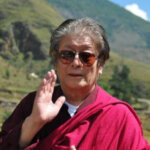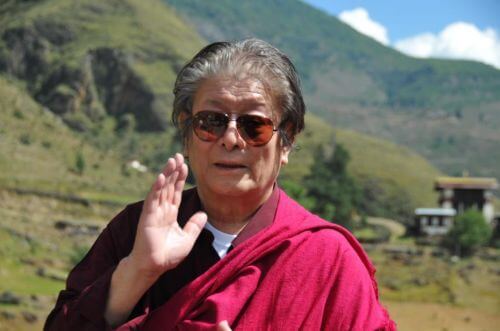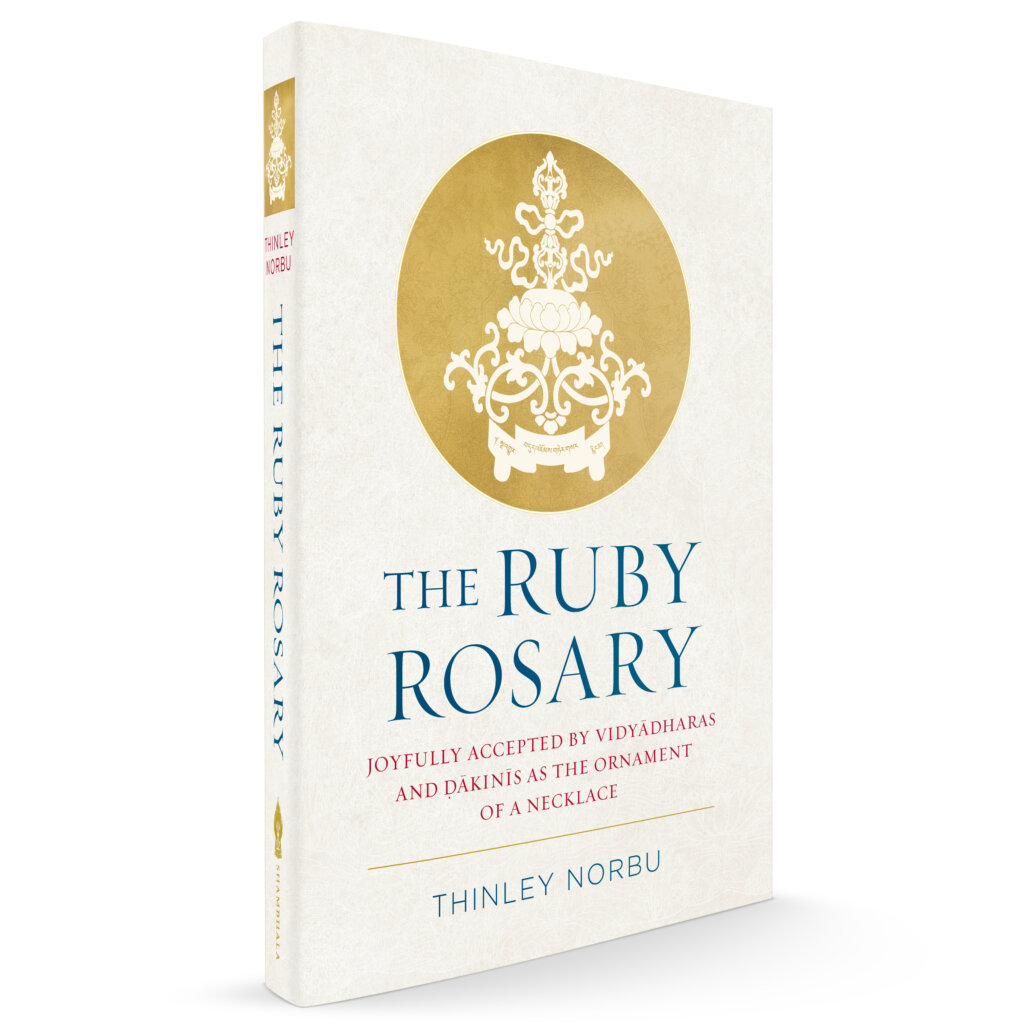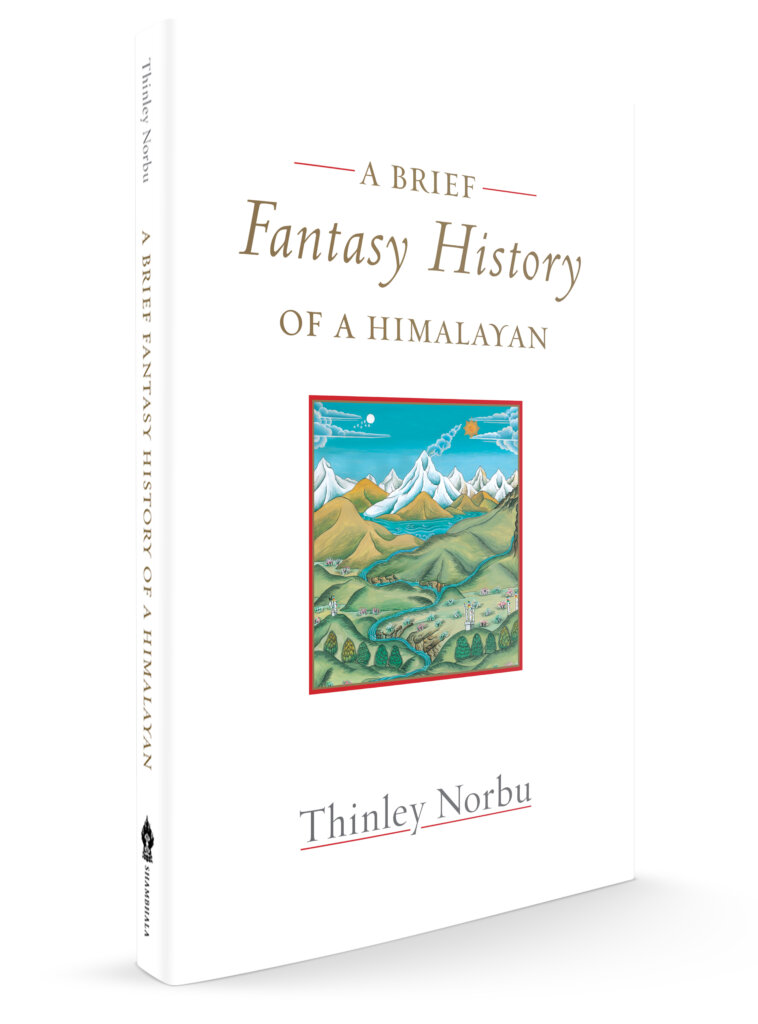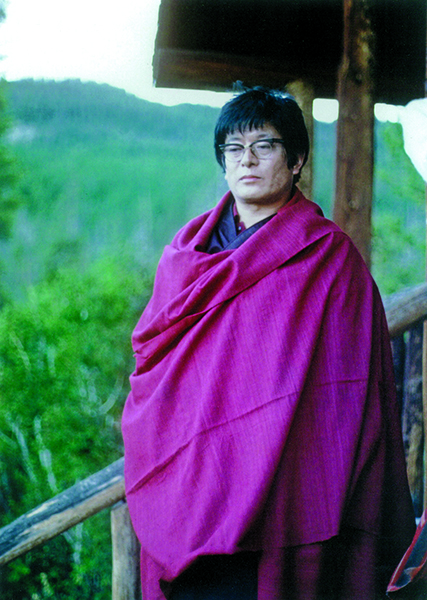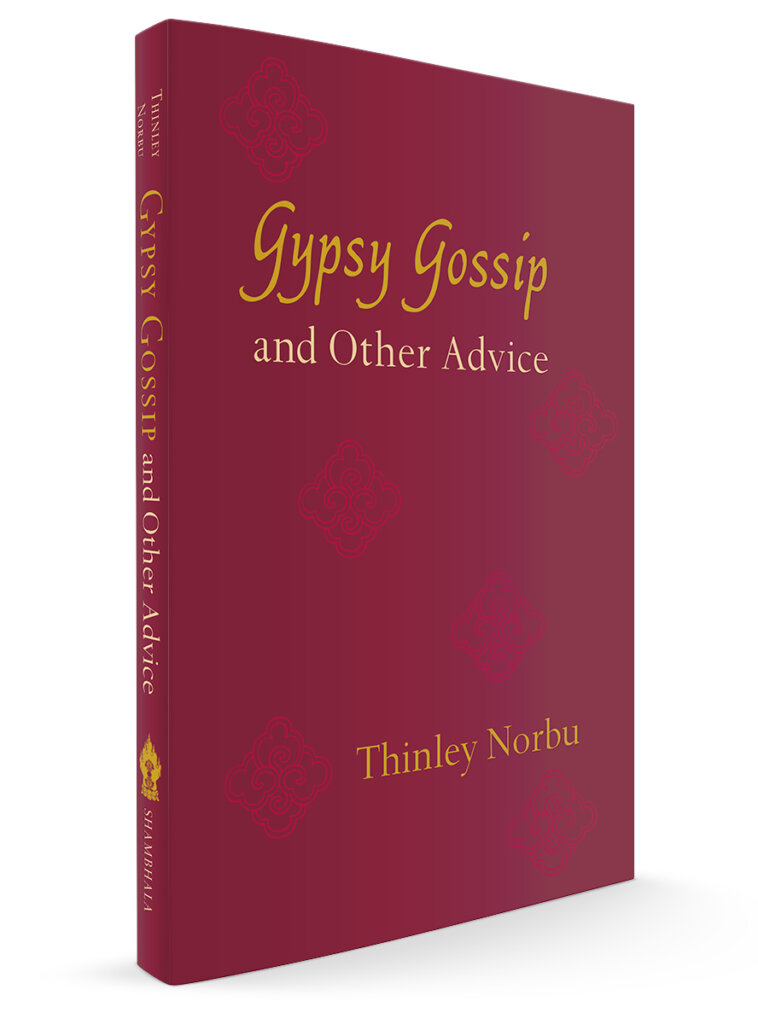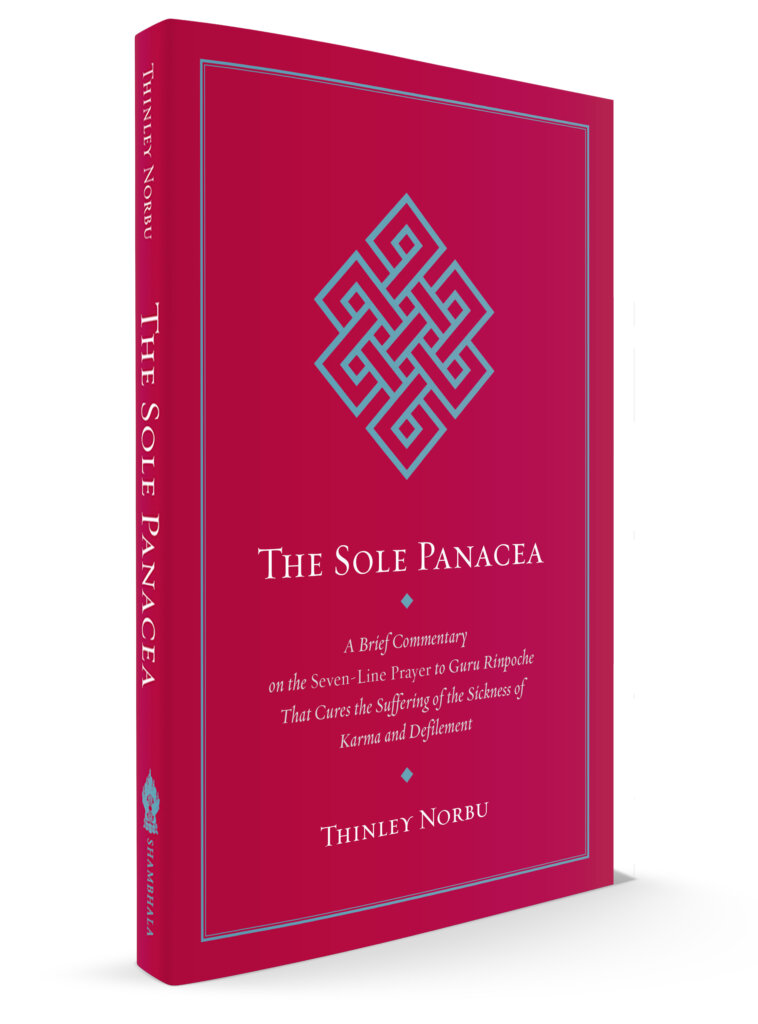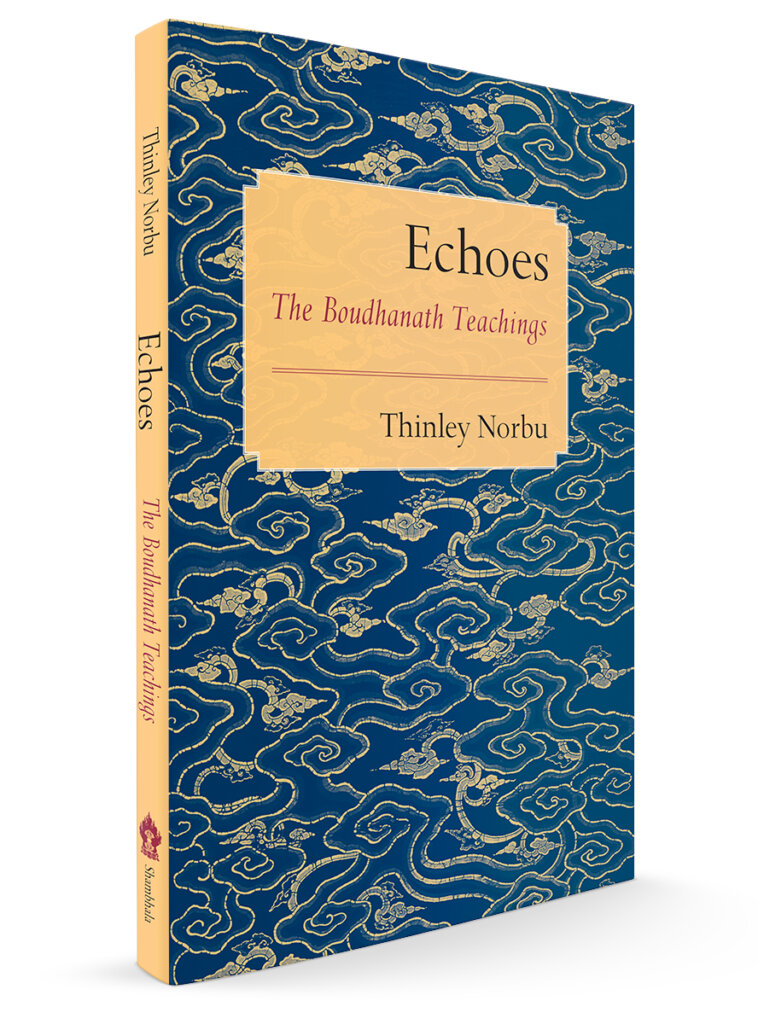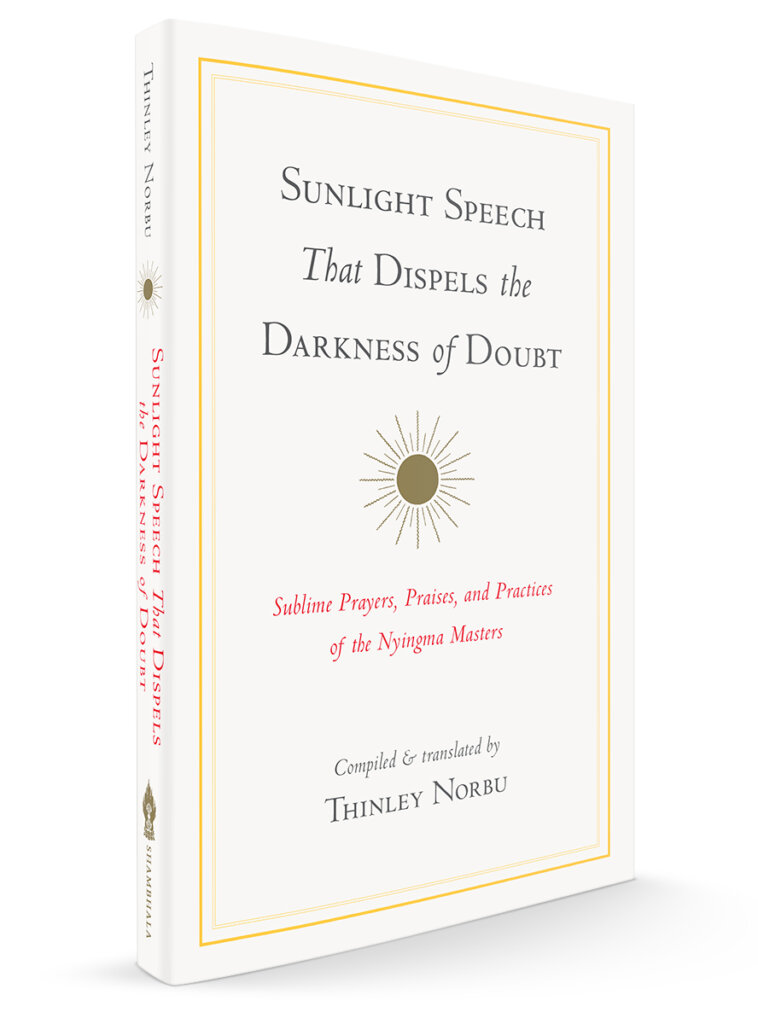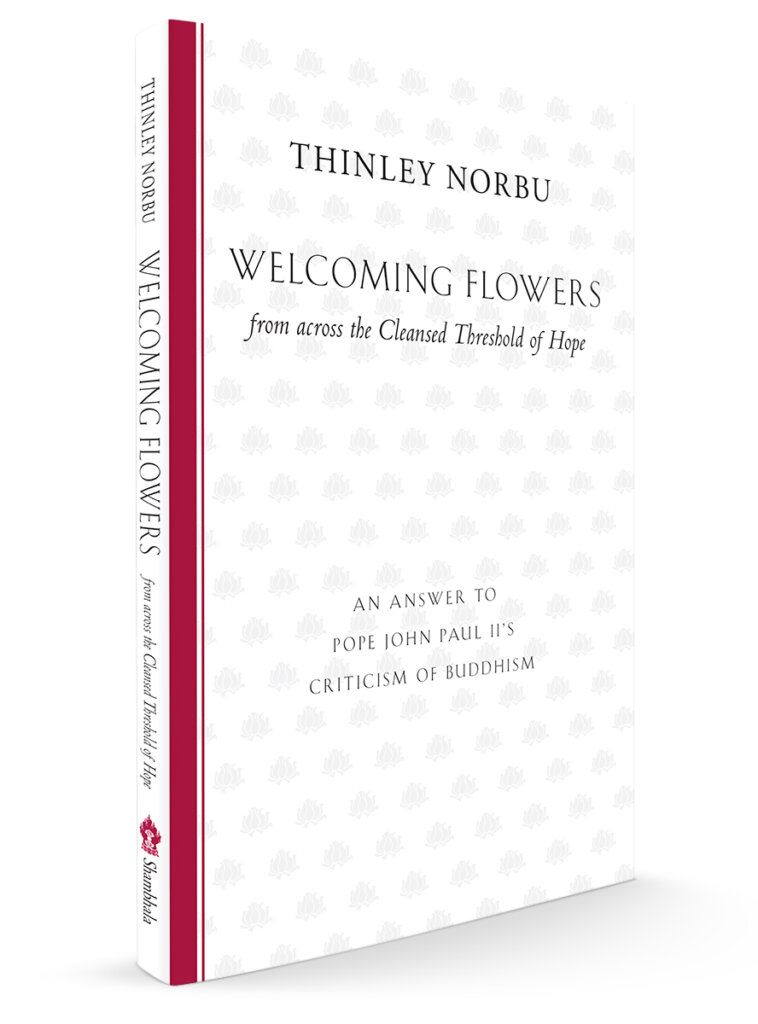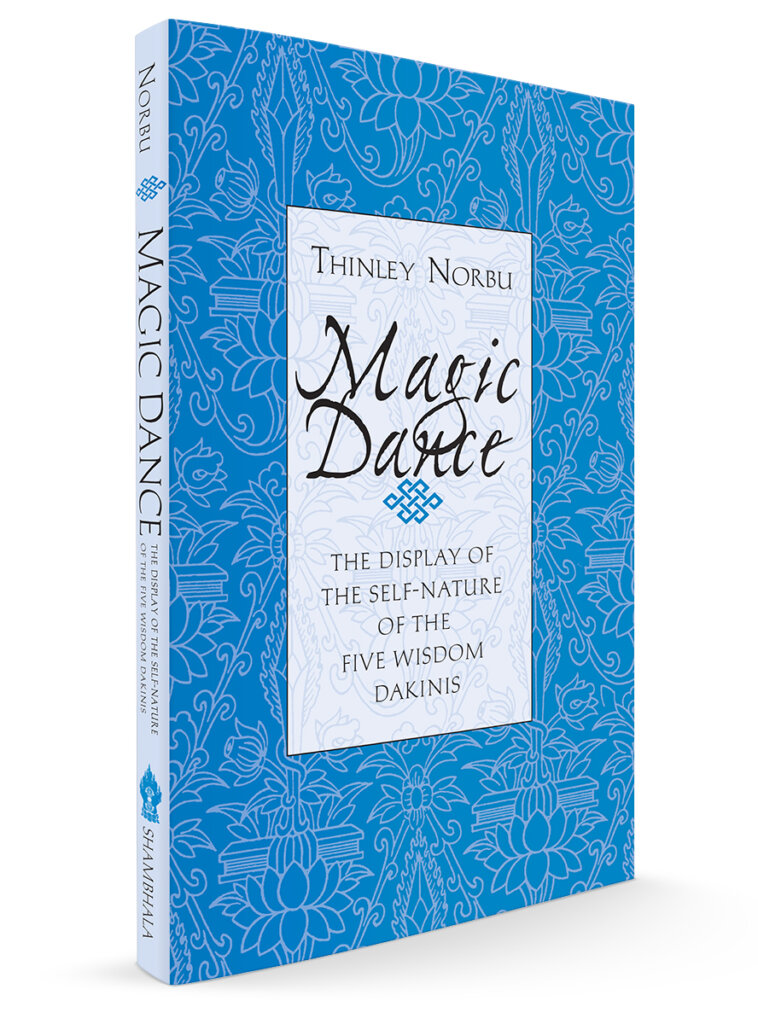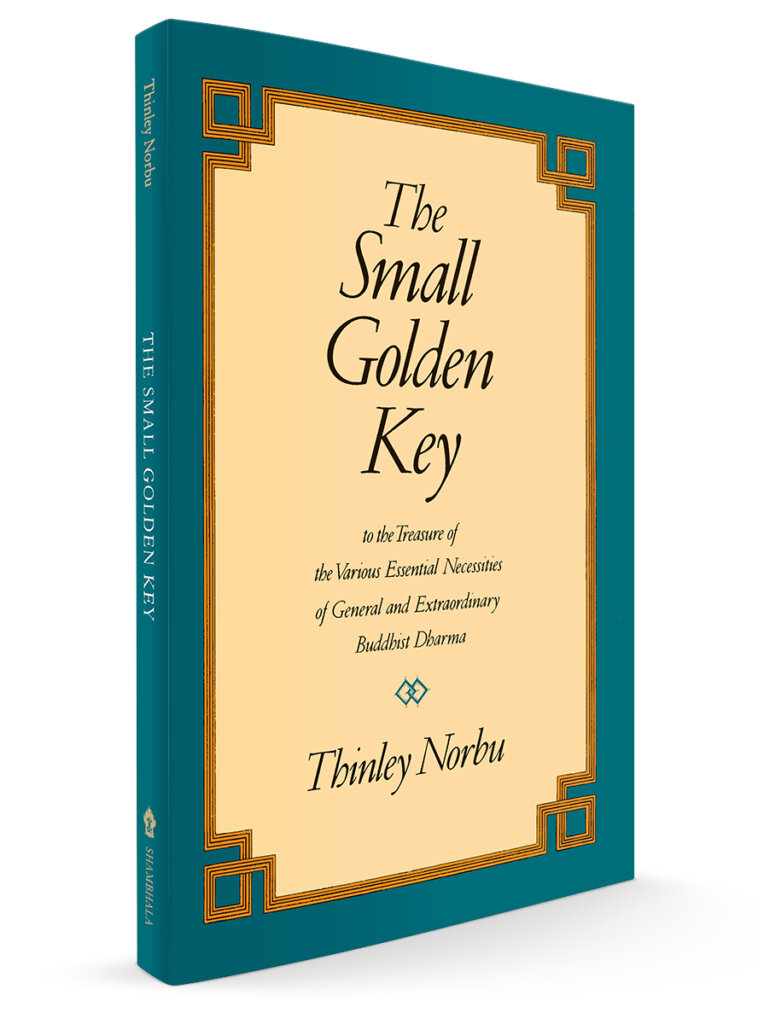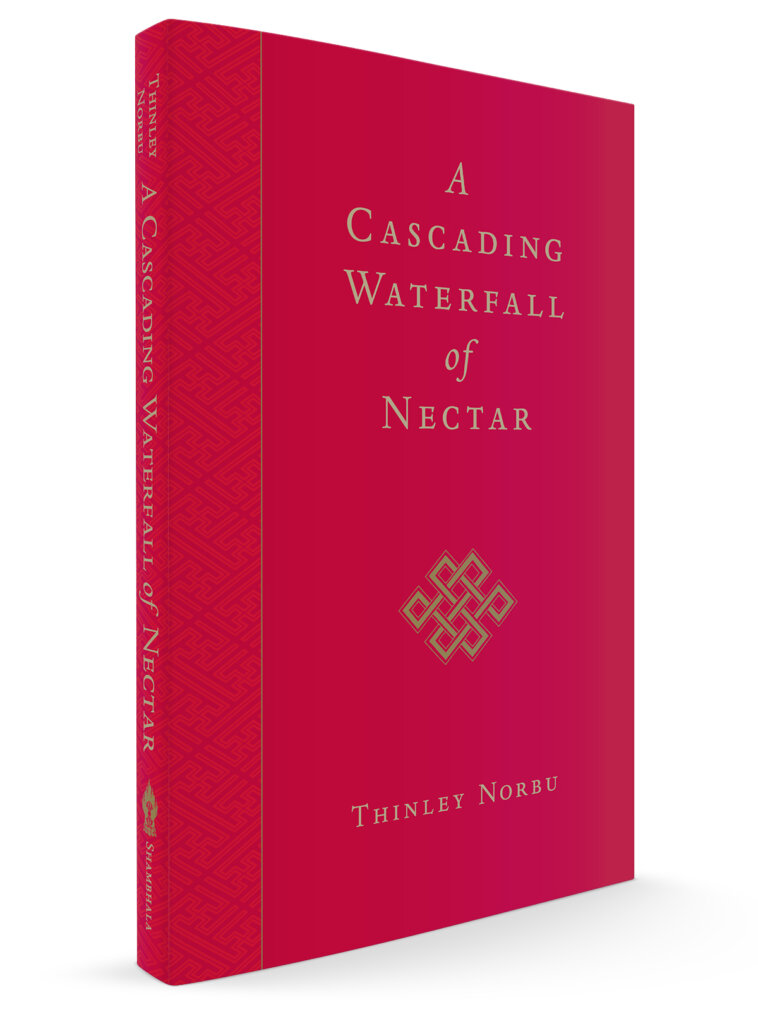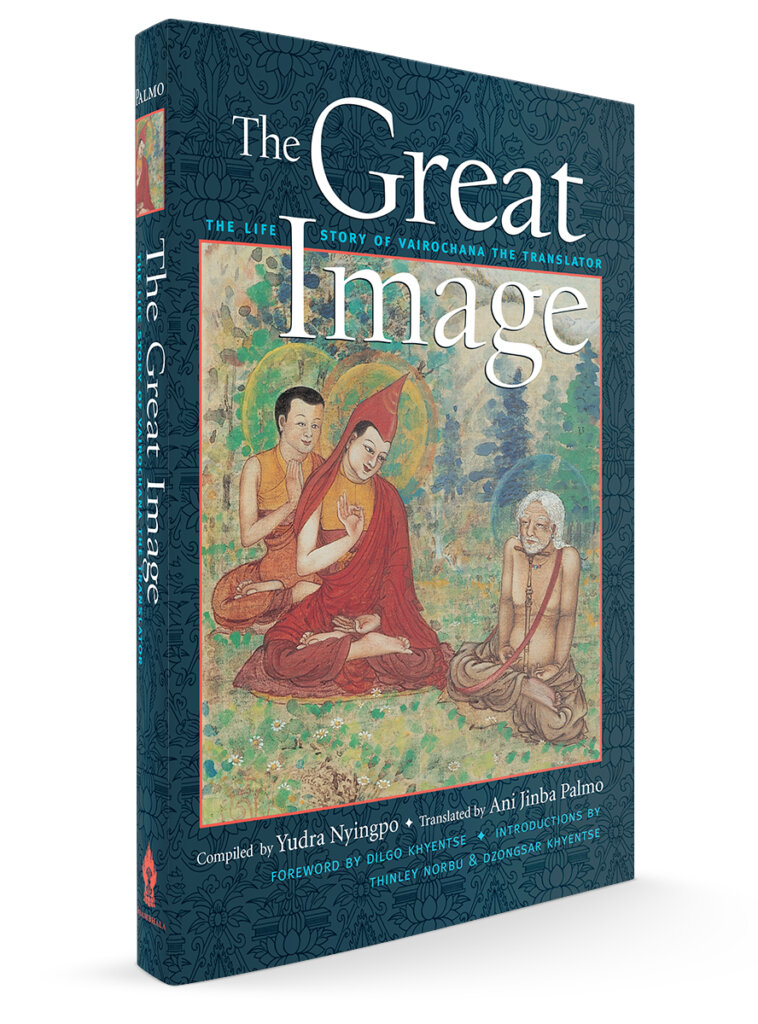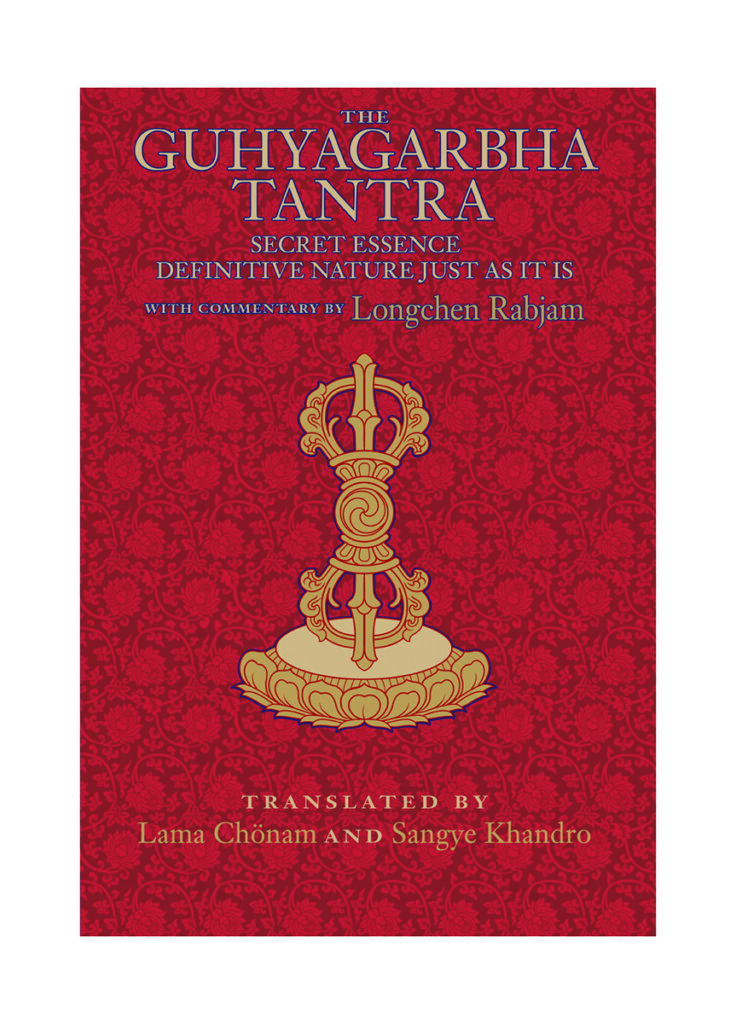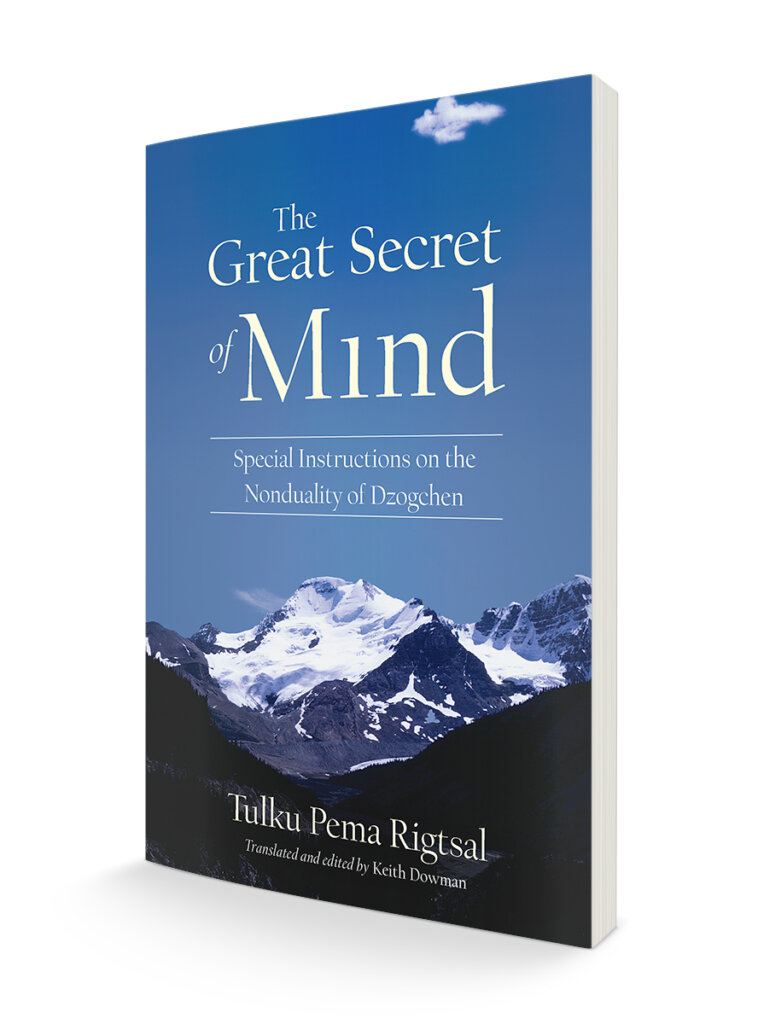Some Nyingma Lineages: Dudjom Tersar | Longchen Nyingtig | Namcho & Palyul
Guides to Other Important Nyingma Figures:
Rongzompa | Longchenpa | Jigme Lingpa | Patrul Rinpoche |
Sera Khandro | Mipham Rinpoche | Dilgo Khyentse | Dudjom Rinpoche
Thinley Norbu Rinpoche (1931-2011) is widely considered one of the most extraordinary Buddhist teachers of the 20th century. His father was Dudjom Rinpoche, Jigdral Yeshe Dorje, and was recognized as an emanation of Longchenpa and reincarnation of Drime Ozer, the son of Dudjom Lingpa. Rinpoche had deep roots in Tibet, Bhutan, and Nepal, where he had many disciples who would come to see him in throngs. Yet like the authentic yogi he was, he eschewed crowds and fame and preferred a life devoted to practice. He lived for decades in the US, settling in upstate New York surrounded by a group of devoted students in a small quiet community, with occasional trips back to Asia. His children include Dzongsar Khyentse Rinpoche and Garab Rinpoche.
The eleven books by Thinley Norbu Rinpoche in English are very difficult to summarize as in almost all cases, their scope, subtlety, and profundity challenge any attempt to quickly describe or categorize. And that is exactly why Rinpoche's books are indispensable and often life changing to those who are open to their incisive observations and expansive view from which they spring.
That being said, what follows is an attempt to capture the flavor of each of these books to give readers a clear idea of where they might like to start.
Latest Releases from Thinley Norbu Rinpoche
Hardcover | Ebook
$39.95 - Hardcover
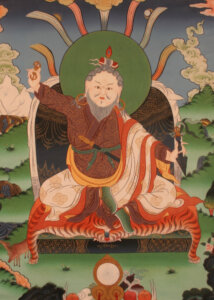
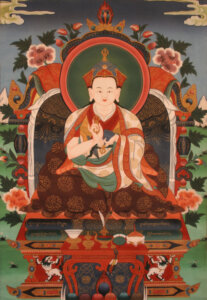
While Thinley Norbu Rinpoche was known as being a yogi and teacher of the Secret Mantra tradition par excellence, his scholarship was second to none. The first half of this work is perhaps one of the clearest presentations of how the teachings of the three yānas of Buddhism came into being, from the previous Buddhas to the coming of Buddha Śākyamuni, to the three councils of the Śrāvakayāna, Bodhisattvayāna, and through the Vajrayāna and Dzogchen.
The Mahayāna receives great detail, with accounts of the lives and importance of figures like Dignāga, Dharmakīrti, Nāgārjuna, Vasubandhu, Āryadeva, Asanga, Vasabandu, Guṇaprabha, Shantideva, Candragomin, Candrakīrti, and more.
The Vajrayāna section gives an account of the tantras of both the Nyingma and Sarma traditions. There is a clear and detailed account of great Tantric figures of India and Tibet as well as the great figures and texts from the Nyingma, Kadam, Sakya, Kagyu, Gelug traditions.
The second half of the book is focused on the Dudjom lineage in particular, whose series of eighteen primary incarnations weaves its way through all the epochs and traditions described in the first half. To list a few:
- Nuden Dorje Chang, the great yogi who lived during the time of the previous Buddha and taught to 1,000 princes destined to become the 1,000 Buddhas of the fortunate eon.
- Śāriputra, the great disciple of the Buddha
- Saraha, the Indian yogi of the Mahāmudrā tradition and teacher of Nāgārjuna
- Krsnadhara, a pivotal figure who served King Indrabhuti and met Padmasambhava as a young boy
- Hūṃkāra, the great master closely associated with the Eight Heruka Sadhanas
- Drogben Khyeuchung Lotsawa, one of Padamasambhava’s main disciples and a great translator
- Smṛtijñāna, the Indian pandita who was a student of Naropa
- Rongzom Chökyi Zangpo, the master ands scholar whose importance in the Nyingma tradition cannot be exaggerated
- Katok Dampa Deshek, the brother of Phakmodrukpa and holder of many traditions, who founded Katok monastery
- Lingje Repa, the great yogi of the Drukpa Kagyu tradition
- Drogön Chögyal Phagpa, one of the great figures of the Sakya school
- Dudjom Lingpa
- Dudjom Rinpoche Jigdral Yeshe Dorje
Thinley Norbu Rinpoche uses as a basis for the explanation of these figures the text entitled “The Pearl Necklace,” a prayer of devotion to these masters of the Dudjom incarnation lineage, “strung together into a necklace of liberated lifetimes.” With lively storytelling, Rinpoche illuminates the life of each of these great masters including a detailed account of the enlightened activities of Dudjom Rinpoche himself, as well as two more figures prophesized to follow, Dorje Nönpo and Möpa Thaye (Buddha Adhimukta).
The work has a foreword by the late Dudjom Yangsi Rinpoche who left us far too soon in 2022, as well as a foreword by the great Alak Zenkar Rinpoche. The lengthy introduction was authored by Lama Tharchin Rinpoche, whose devotion to Thinley Norbu Rinpoche was a model for all practitioners.
A Brief Fantasy History of a Himalayan: Autobiographical Reflections
Rinpoche wrote these words about this autobiographical work:
"I wrote Brief Fantasy History of a Himalayan in the countryside of New York in the springtime amid swaying weeping willow trees because some of my loving American friends requested me to tell my life history. They helped me through their fanatical, positive hallucination phenomena toward me and my speech which is like brass, but which they saw like pure gold and tried to make as an ornament for the Buddha's teaching."
This stands as an incredible document of a life of a mahasiddha, tracking his early life with his father Dudjom Rinpoche, and many other great masters in Tibet, Nepal, Bhutan, and the US. But this book is also brimming with profound wisdom and advice readers. Here is a sample passage:
Paperback | eBook
$22.95 - Paperback
Gypsy Gossip and Other Advice
Rinpoche wrote of the main part of this work:
"I wrote Gypsy Gossip because there was so much paranoia between the negative and positive fashions of current spiritual ideas and between the different religious habits of nihilists and spiritualists".
The first selection, the eponymous “Gypsy Gossip,” was originally printed in 1980 as a small book in a very limited private edition. In its present edition it is happily now available to a wider audience. In an informal atmosphere of spiritual openness, Kyabje Thinley Norbu Rinpoche answers questions from Western students about Tibetan Buddhism, including the teachings of karma and rebirth, monastic discipline, devotion to the Guru, and the importance of keeping vows.
“Beyond East and West” consists of Rinpoche’s written replies to questions submitted in writing by Melvin McLeod, editor-in-chief of Buddhadharma and Shambhala Sun magazines, during a visit to Rinpoche’s residence in Delhi, New York, around 1999. In this interview, published here for the first time, Rinpoche gives an extensive commentary on how cultural differences have affected the adoption of Tibetan Buddhism in the West, and emphasizes that Westerners’ Buddha nature can be rekindled through a greater development of faith and belief.
“A Message for Young Bhutanese” was written for an organization called the Young Buddhist Association of Bhutan. Rinpoche had a close personal connection with the kingdom of Bhutan. In this message Rinpoche urges Bhutanese youth to preserve their spiritual heritage (including study of the Tibetan language) and to carry its blessings onward amid the modern influences of materialism. Rinpoche warns against introducing foreign nihilistic beliefs into Bhutan and creating sectarian conflicts between its indigenous lineages.
“An Introduction to Dharma Dance Offerings” was written in connection with several teaching films directed by Kyabje Thinley Norbu Rinpoche, who was an accomplished practitioner and teacher of sacred dance. Rinpoche contrasts ordinary dancing, which expresses the passions of material reality and lacks the positive influence of wisdom, with the Dharma dances of Tibet, which manifest the enlightened activities of peaceful and wrathful deities.
Paperback | eBook
$19.95 - Paperback
The Sole Panacea: A Brief Commentary on the Seven-Line Prayer to Guru Rinpoche That Cures the Suffering of the Sickness of Karma and Defilement
The Sole Panacea is a slim volume on the Seven Line Prayer to Guru Rinpoche, one of the most important and profound prayers which holds multiple layers of increasingly subtle meaning. However, it covers a lot more. The first half of the book includes teachings on:
- The beliefs of various doctrines of eternalism and nihilism, which depend on the temporary circumstances of the agreement or disagreement of phenomena and objects of phenomena.
- The reason that wanting to understand the immaterial, absolute nature of mind with the help of material scientific technology is building a castle of sand, which can never be reliable; and how important it is to actually believe in the three supports of worship and holy places, mountains, and caves.
- Dispelling the doubts that have circulated discriminating between Padma Jungne who came to Tibet and Padmasambhava.
- A debunking of the claim that Jatsön Nyingpo is the only fully ordained tertön, and how this contradicts both Buddha’s speech and logic.
- The views of the various doctrines of Buddhism
- The various ways of recognizing the Triple Gems, the object of refuge, in the common and uncommon vehicles
- The way that Hīnayāna does not accept Mahāyāna, and the Mahāyāna reply that clears this contradiction.
- A summary of the various beliefs of the higher and lower vehicles.
- The definition of "Chomdendé" and the histories of peaceful and wrathful deities.
With that as a substantial prelude, the Seven Line Prayer comes into sharp focus. First is a historical account of the origin of the Seven-Line Prayer and the greatness of its blessings. The pure mindfulness of practicing the outer meaning of the Seven-Line Prayer. And fnally explaining how to approach practicing the inner meaning of the Prayer.
Paperback | eBook
$18.95 - Paperback
Echoes: The Boudanath Teachings
Of this short but penetrating work, Rinpoche wrote,
"Echoes contains what I taught in Boudhanath with many international Dharma yogis and yoginis, using the traditional method of question and answer to connect ordinary experience with sublime Dharma in a flexible way.""
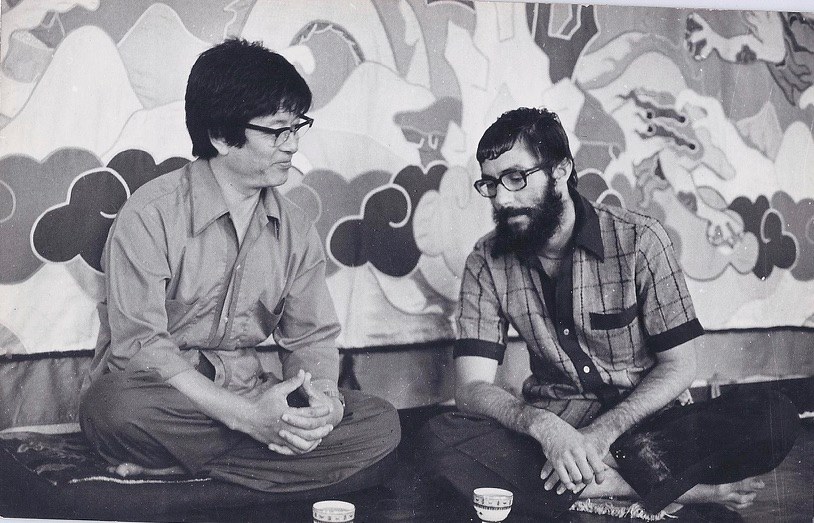
Thinley Norbu Rinpoche giving the teachings that formed Echoes. Photos courtesy of the translator, Shakya Dorje, shown here.
In colorful, bustling Boudhanath—Buddhism's great pilgrimage site in Nepal—a small group of students gathered to speak with Kyabje Thinley Norbu Rinpoche in an informal, relaxed atmosphere. This is the record of their lively dialogue. The contents cover a wide range of inquiry: How should Westerners understand the Tibetan Buddhist teachings on karma and rebirth, monastic discipline, the importance of keeping vows, and devotion to the Guru? What is the Buddhist stand on male supremacy? Must Vajrayana practitioners have a consort? What is the antidote to self-hatred? How do we put into practice the “same taste” of suffering and pleasure? Echoes is part of the cherished legacy of one of the greatest realized Nyingma masters of our age. Here is a sample passage:
Paperback | Ebook
$19.95 - Paperback
Sunlight Speech That Dispels the Darkness of Doubt: Sublime Prayers, Praises, and Practices of the Nyingma Masters
By Longchenpa, Jigme Lingpa, Jamgon Mipham, Dudjom Rinpoche, and Patrul Rinpoche
In this sublime revision, Kyabje Thinley Norbu Rinpoche has translated a selection of wisdom teachings into direct and simple English that retains the power of the original writings and their emphasis on practice. The authors are five of the most sublime scholar-saints of the Nyingma lineage of Tibetan Buddhism: Kunkhyen Longchenpa, Kunkhyen Jigme Lingpa, Patrul Rinpoche, Mipham Rinpoche, and Kyabje Dudjom Rinpoche. Their compositions include words of advice, poetic praises, concise daily prayers, and liturgies accompanied by instructions. Written over a span of time from the medieval to the modern era, these precious teachings are intended to be the cornerstones of faith, practice, and enlightenment.
Praises
- Praise to Longchenpa
- Praise to Jigme Lingpa
- Praise to Manjushri by Mipham Rinpoche
- Praise to the Melodious Wisdom Goddess Saraswati Called “The Melody of the Youthful Display of Joy” by Kunkhyen Longchenpa
- Praise to Patrul Rinpoche by Jamyang Khyentse Wangpo
- Praise to Mipham Rinpoche
- Praise to Dudjom Lingpa by Kyabje Dudjom Rinpoche
Teachings and Sadhanas
- The Practice of the View, Meditation, and Action, Called “The Sublime Heart Jewel”: The Speech Virtuous in the Beginning, Middle, and End by Patrul Rinpoche
- Mindfulness, the Ocean of Qualities by Rigdzin Jigme Lingpa
- The Lion’s Roar: Cutting Through the Errors and Deviations of the One Free from Activity, Meditating on the Heart Essence by Rigdzin Jigme Lingpa
- Always Rejoicing in the Forest by Kunkhyen Longchenpa
- Praise of the Ten Deeds of Buddha by Rigdzin Jigme Lingpa
- The Treasure of Blessings of the Ritual of Buddha by Mipham Rinpoche
- The Sadhana of Fully Enlightened Supreme Vajrasattva, Called “The Daily Practice of the Profound Path, Contained in Essence” by Kyabje Dudjom Rinpoche
- The Rain of Blessings: Guru Yoga in Connection with the Seven-Line Prayer by Mipham Rinpoche
- The Assembly Palace of Great Flawless Exaltation,Radiant Lotus Light by Kyabje Dudjom Rinpoche
- Calling the Lama by Kyabje Dudjom Rinpoche
- The Guru Yoga of Receiving Wish-Fulfilling Great Flawless Exaltation by Kyabje Dudjom Rinpoche
Paperback | eBook
$19.95 - Paperback
Welcoming Flowers from across the Cleansed Threshold of Hope: An Answer to Pope John Paul II's Criticism of Buddhism
Welcoming Flowers is a pointed critique of the Buddhism chapter of Pope John Paul II’s 1994 best seller, Crossing the Threshold of Hope, written at the request of some Polish students. In responding to the false charges of Buddhists’ indifference to the world and rejection of reality, Rinpoche clarifies the Buddhist doctrines of detachment and enlightenment. In addition, he covers the topics of good and evil, human nature, karma, cosmology, and dualistic mind, bringing them into conversation with the Christian perspective as presented by the Pope. The intention is not to shoot back arrows in an attack on Catholicism but to spread “welcoming flowers”—that is, to present the exalted teachings of the Buddha in all their loveliness. In this sense, the book serves as a helpful introduction to the Buddhist worldview.
Paperback | eBook
$19.95 - Paperback
Magic Dance: The Display of the Self-Nature of the Five Wisdom Dakinis
Of this singular work, Rinpoche wrote,
"Through the circumstance of a good friend's desire to know about how the elements work within beings, I wrote Magic Dance: The Display of the Self-Nature of the Five Wisdom Dakinis in New York and Paris, very naturally, without putting in many different traditional category systems or ideas".
Here is an excerpt:
Paperback | eBook
$19.95 - Paperback
The Small Golden Key: To the Treasure of the Various Essential Necessities of General and Extraordinary Buddhist Dharma
On this short book, Rinpoche wrote, "The Small Golden Key , which I wrote in Honolulu, is predominantly very compact. In it, I hastily synthesized the essence of different Dharma ideas according to the three yanas."
Here Rinpoche explains in simple, concise language the important ideas and practices of Buddhism, with special attention to the Vajrayana teachings of Tibetan Buddhism. He discusses the origins of Buddhism in India and its spread to Tibet; the important lineages of Tibetan Buddhism, with emphasis on the Nyingma school; the differences between the Hinayana, Mahayana, and Vajrayana teachings; the outstanding features of the Mahayana; and some of the special qualities and practices of the Vajrayana.
An excerpt from the chapter on Two Truths from this work is included in The Dzogchen Primer.
White Sail: Crossing the Waves of Ocean Mind to the Serene Continent of the Triple Gems
Of this incredible book on ascertaining the correct view, Rinpoche wrote,
"Because everyone likes to create contradiction between nihilist scientific and spiritual ideas in this degenerate age, making conflicts between tangible and intangible qualities, I tried to make complementary connections and harmony by writing White Sail".
This book defies easy description, but when reading it with an open state of mind, this book is a serious and deeply meaningful work. Here is a sample:
Paperback | eBook
$24.95 - Paperback
Paperback | eBook
$28.95 - Paperback
A Cascading Waterfall of Nectar
With Forewords by H. H. Drubwang Penor Rinpoche, Kathog Rigdzin Pema Wangchen Rinpoche, Ven. Alak Zenkar Rinpoche, and Tulku Thondup Rinpoche.
Many consider this work to be one of Rinpoche's most important works. On the surface it a commentary on the preliminary practices (ngöndro) of the Dudjom Tersar lineage. But like all Rinpoche's books, that simple description belies the depth of this work.
Note: The paperback edition is actually quite different from the hardcover. There are hundreds of changes to the text, mostly words and phrases in the translation, and particularly significant changes in the section on the commentary on Dudjom Rinpoche's prayer, The Meaning of “The Continuously Blossoming Rosary of the Lotus Assembly Palace” Called The Light Rays of the Youthful Sun (Tsok Khang Dechen).
Much more than a "how to" explanation, Rinpoche goes into great length on the the profound view, through which the preliminary practices are best engaged. Here is a short sample:
Additional Contributions from Thinley Norbu
Peperback | eBook
$34.95 - Paperback
The Great Image: The Life Story of Vairochana the Translator
Compiled by Yudra Nyingo, Translated by Any Jinba Palmo
Foreword by Dilgo Khyentse Rinpoche
Introduced by Thinley Norbu Rinpoche and Dzongsar Jamyang Khyentse Rinpoche
This book is the autobiography of the great scholar and translator Vairochana, as told to a group of his students near the end of his life in the eighth century. Responsible for bringing seminal Buddhist teachings to Tibet from India, his deep understanding of the Dharma was what enabled him to translate the essence of enlightened mind, conveyed in the Sanskrit texts, with great accuracy.
In Rinpoche's seven pages of introduction, he includes the following:
"Particularly, when one reads any books about Dharma, including the histories of sublime beings, I must beg readers first to recognize the characteristics of the two different kinds of magic. Black magic is the suffering of samsara that tortures beings who are grasping at unreal phenomena such as time, place, and the similarity or dissimilarity of the nature of beings and their ideas, while thinking they are real. These beings circle between rejection and acceptance and continuously suffer because there is no certainty that phenomena exist. This black magic should be abandoned because it always lures us, pretending to be true, even though it is not, created by deluded habit as it is. White magic, on the other hand, is the manifestation of wisdom qualities of all sublime beings, which is the non-grasping freedom of the display of unobstructedness, without any thought of anything within time and space or of the similarity or dissimilarity of the nature of beings and their ideas, and without rejection or acceptance, manifesting continuously in exaltation because no certainty or uncertainty exists within nondualistic wisdom. White magic always brings us the inspiration of joy, always creates love and faith, and always brings about compassion and wisdom, which are the sources of enlightenment, not pretending to be either real or unreal, which is the uncreated manifestation of self-accomplishment.
So whenever we have the time and space, we should read biographies of sublime beings and ponder their qualities in order to receive their blessings and go beyond time and space as they have done. There are many biographies of sublime beings from Tibet; among them, one of the most precious is the life history the Great Image of Vairotsana. Since the wisdom of dharmakaya lacks characteristics, being indivisible from this unceasing dharmakaya, the wisdom manifestations of rupakaya radiate in various forms. As it is said in the Guhyagarbha Tantra:
The wisdom body has no front or back;
The wisdom face sees clearly in all directions.
I pray that all sentient beings, including all those who have made the great connection with this book, may attain the state of gyalwa namnang kuntu shal, which means “the face that is everywhere,” the aspect of manifestation that is the origin of all victorious wisdom forms."
Hardcover
$150.00 - Hardcover
The Guhyagarbha Tantra: Secret Essence Definitive Nature Just as It Is
By Longchenpa and translated by Lama Chonam and Sangye Khandro
Foreword by Thinley Norbu Rinpoche
Rinpoche includes the following in his foreword:
"The ultimate source for the entirety of Sūtra and Tantra is the King of Tantras, The Guhyagarbha. Based on that Glorious Secret Essence, this commentary was written by one who elucidated it through the six limitations and four modes1 to those who are the fortunate recipients. This commentary is the ambrosia of the enlightened speech of the omniscient Longchenpa, who was an actual manifestation of Samantabhadra. So that the flowing river of these blessings will not diminish even during these degenerate times, the great Khenpo from Namdroling in the Land of the Āryas [i.e., India] has revealed this path to all beings who made a connection and will guide them to the state of perfect liberation [i.e., Namdrol], the pure land of the three kāyas."
The twenty-two chapters of this tantra elucidate how to correctly view the ground, traverse the path, and ultimately reach the result—fully enlightened buddhahood. The first part of this book includes the Tibetan and English translation for the root tantra itself. The second part is a translation of the extensive commentary on The Guhyagarbha Tantra called Thorough Dispelling of Darkness throughout the Ten Directions, written by the omniscient Longchenpa, who was an emanation of Samantabhadra. His word-for-word commentary gives uncommon explanations regarding all stages of Vajrayana practice, including comprehensive teachings from the Dzogchen point of view on how to practice and accomplish the path to enlightenment. The author includes complete explanations of the peaceful and wrathful mandalas as well as practical instructions needed to attain the four states of vidyadharahood.
Note that this is a restricted text. See Sangye Khandro's advice on restricted material.
Paperback | eBook
$27.95 - Paperback
The Great Secret of Mind: Special Instructions on the Nonduality of Dzogchen
By Tulku Pema Rigtsal, Translated by Keith Dowman
Introduction by Thinley Norbu Rinpoche
In the several page opening of the book, Rinpoche introduces the author of the book, his background, and his experience of him.
Weaving in personal stories and everyday examples, Pema Rigtsal leads the reader to see that all phenomena are the spontaneous display of mind, a magical illusion, and yet there is something shining in the midst of experience that is naturally pure and spacious. Not recognizing this natural great perfection is the root cause of suffering and self-centered clinging. After introducing us to this liberating view, Pema Rigtsal explains how it is stabilized and sustained in effortless meditation: without modifying anything, whatever thoughts of happiness or sorrow arise simply dissolve by themselves into the spaciousness of pure presence. The book is divided into chapters on the view, meditation as the path, conduct, the attainment, and the four bardos. Each chapter consists of mini-sections that can be read as stand-alone Dharma talks. Pema Rigtsal has studied and lived with several authentic Dzogchen masters and has surprising stories to tell about their unconventional methods to introduce students to the subtle view of Dzogchen.
Reader Guides Related to Thinley Norbu Rinpoche
Check out more reader guides on Tibetan Buddhism!
Additional Resources

The first is the long life prayer he wrote for Alak Zankar Rinpoche.
The second is A Supplication to Realize the Profound by Jamyang Khyentse Chökyi Lodrö which he wrote at the request of Thinley Norbu Rinpoche. And of course Jamyang Khyentse Chökyi Lodrö's rebirth is Dzongsar Khyentse Rinpoche, his son.
The third is the Short Prayer to Abbot, Master and King written by Dudjom Rinpoche at Samye Monastery, at the request of his son.

